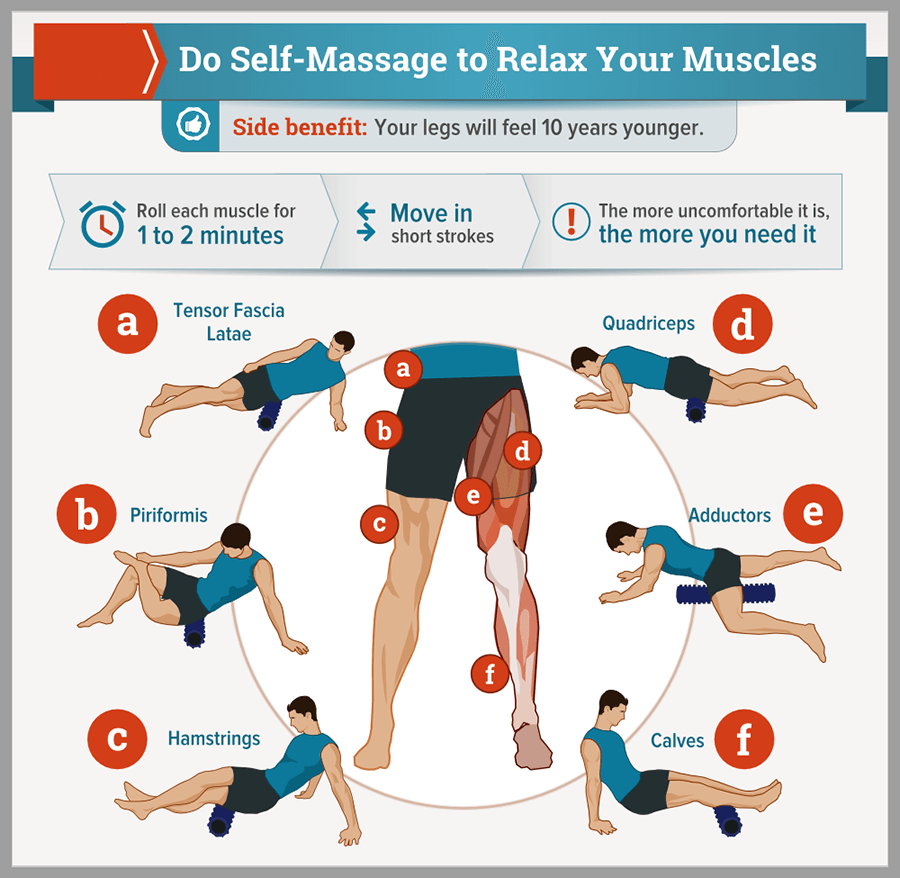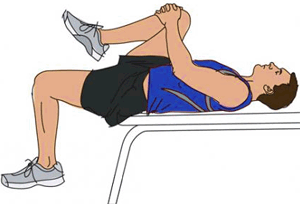The iliotibial band (IT Band) is a thick layer of connective tissue that runs down on the outside of your thigh from your hip to your shin bone.
The purpose of the IT band is to stabilize the knee and it also serves as an attachment area for the insertion of tensor fascia latae, gluteus medius and gluteus maximus.
But what if this thick sheet of fascia causes problems?
Will ITB stretches be enough?
In this post we go beyond simple IT band stretches and also look at the underlying causes for iliotibial band problems.
IT Band Stretches Are Not Enough
If you suffer from iliotibial band friction syndrome you have probably been told to do ITB stretches, but just doing IT band stretches will not be sufficient to improve tissue quality of the IT band and connected fascia.
For example the iliotibial band sometimes attaches to the vastus lateralis underneath and these adhesions need to be released before doing ITB stretches, in order for the stretches to be effective.
In other cases soft tissue problems with the muscles that insert into the ITB can add excess tension. IT band stretches will not be successful in completely relieving your pain, if those soft tissue problems (adhesions, scar tissue, etc.) are not dealt with first.
With that in mind, it is obvious that doing ITB stretches will only solve parts of the problem. A more holistic approach to ITB stretches will yield better results and ensure long-term improvement.
Additionally, if you suffer from IT band syndrome, you have to include specific exercises that target your gluteals. You can find several good gluteal exercises here:
Do This Before Stretching
Before getting started with the ITB stretches we need to address tissue quality of the tensor fascia latae, gluteus medius, gluteus maximus and the IT band itself. You can do this at home by using a foam roller, tennis ball, lacrosse ball or a similar implement.
A few words of caution:
Foam rolling should not be used on body parts that you have recently suffered an injury to. You should also consult your physician about foam rolling if you have circulatory problems or chronic pain conditions such as fibromyalgia.
Please also take note that while foam rolling is a cheap and easy way to improve tissue quality, results will not appear overnight. You may have to work on your fascia daily for a week or two in order to see, or rather feel, improvement.
The target of foam rolling is your soft-tissue. So you should not be rolling your joints or other bony structures. Foam roll a certain tissue for a minute or two, then switch to a different body part.
Frequency trumps duration, so you’re better off foam rolling a certain muscle three times a day for a minute than if you rolled it 3 minutes at once.
The tissues you want to focus on are:
- TFL
- Gluteus Medius
- IT Band proper
- Gluteus Maximus
- Vastus Lateralis
Here’s an overview of the respective muscles:

The IT Band Stretches
Now that you have improved the soft-tissue quality in critical areas we can move on to actually stretching the IT band. In the following part you will find a collection of ITB stretches, out of which you can pick what works best for you.
Remember: you should feel the stretch on the outside of your hip and while the ITB stretches also pull on your IT band, you will most likely not feel it there (in contrast to the foam rolling). For the IT band stretches to be effective just relax and release tension.
Ease into the stretch and don’t force too much range of motion. Persistence is your biggest ally in stretching.
I recommend you do these ITB stretches (pick your favorite variation) once a day after the foam rolling. Performing these drills daily will be a lot more beneficial than just doing them once or twice per week.
Once your tissue quality and flexibility has improved you can dial the frequency down to doing the ITB stretches and the foam rolling every 2 days.
ITB Stretch Against the Wall

To perform this ITB stretch you set up with your side towards a wall, bend the leg that is away from the wall and place it forward, while keeping the other leg straight.
In the beginning the setup will be a bit tricky and it takes some time to find a “comfortable” way of doing this. Once you’ve found your position for this ITB stretch, try to sink down keeping your torso upright or slightly bent away from the wall.
You should feel the stretch on the outside of your hip. You can increase the intensity of this ITB stretch by leaning away from the wall. Always keep the bottom leg straight. It helps to have a surface that prevents the foot of the working leg from slipping away from the wall.
One way to progress faster in this stretch is by pushing the bottom foot into the floor for a couple of seconds and then relaxing into the stretch once you stop pushing.
The reverse Cossack

This drill is from Pavel Tsatsouline’s book “Relax into Stretch”.
The setup is similar to the previous ITB stretch, but in this version you support your weight with your hand on a chair or other sturdy object.
The starting position is slightly different, as you start leaning towards the chair somewhat. Once you’ve found your setup you not only sink down, but also slightly towards the chair.
You need a non-slip surface for the chair and your foot in this one. As with the previous stretch you can press into the floor with your bottom leg and then relax into the stretch.
Modified Thomas Test
 In his book “Fixing you: Hip and Knee Pain” Rick Olderman describes another ITB stretch. This ITB stretch is basically a modified Thomas Test.
In his book “Fixing you: Hip and Knee Pain” Rick Olderman describes another ITB stretch. This ITB stretch is basically a modified Thomas Test.
To perform this stretch you lie down on a table or the floor with both knees pulled to your chest. Now use one hand to find your anterior superior iliac spine (the bony ridges on the front your hip).
Without letting your hip rotate, you now let one leg slowly extend forward. Only go as far as you can go without letting your hip rotate. If you can’t find the bony prominence (ASIS) on your hip you can also pay attention to having your lower back not come off the surface.
In the advanced version you would lie on a table with your feet hanging off the table, as shown in the picture.
As with the basic version you will have to pay attention to not rounding your lower back or letting rotate. Olderman suggests using light weights to increase the stretch.
Here’s a video demonstration of this stretch.
Final Steps
If you need the ITB stretches to achieve high quality of movement in your training you would obviously do them before your training, but also on your rest days.
On the rest days I recommend you do simple movement drills after the stretches. Something like deep squats and deep lunges, but pay close attention to your movement quality.
This way you can slowly reprogram proper movement patterns, while using your body in a natural manner that won’t add additional training stress.
If you want to know more about all requirements knee health you sign up to my free email course about getting rid of knee pain below.

